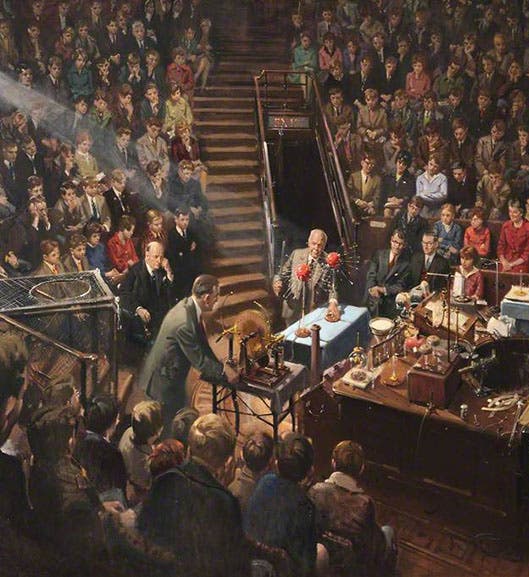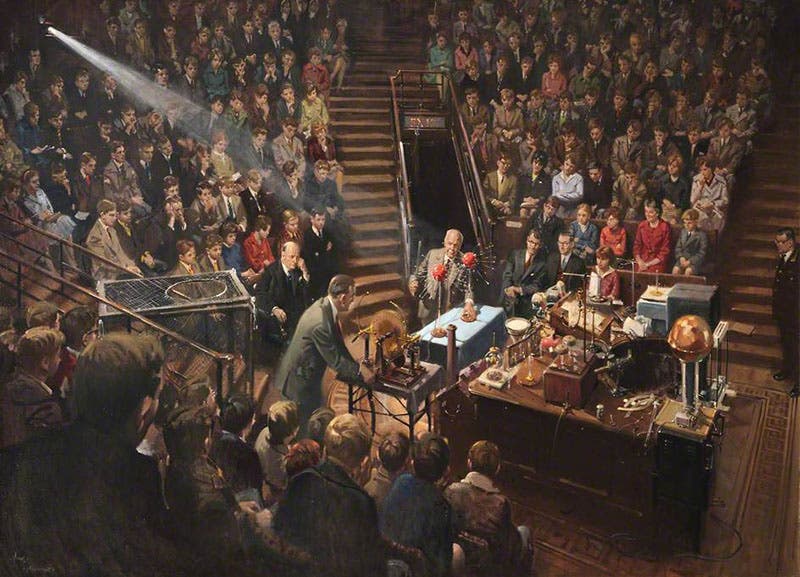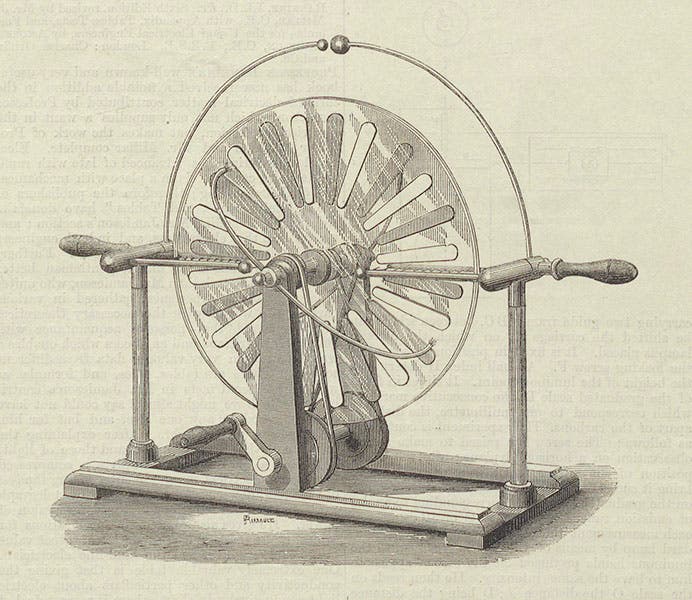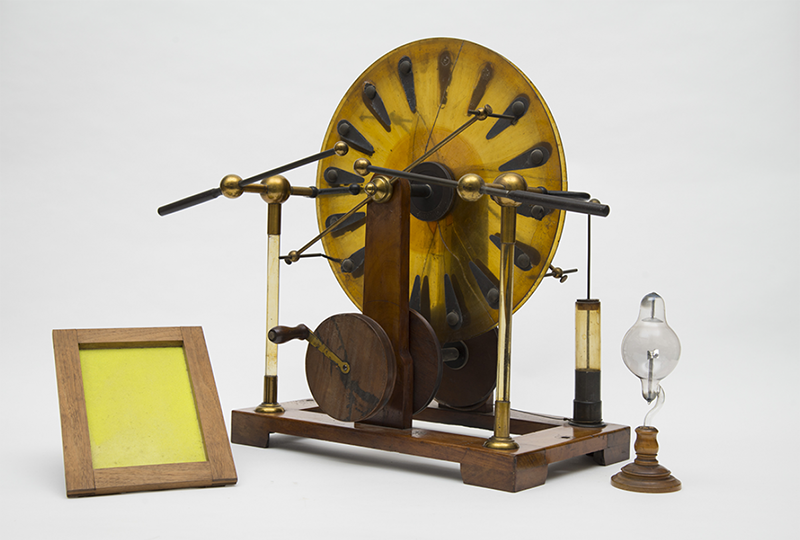Scientist of the Day - James Wimshurst
James Wimshurst, a British electrical engineer and inventor, was born in London on April 13, 1832. His father, Henry Wimshurst, oversaw the construction of the SS Archimedes (the first steamship driven by a screw-shaped propeller) and nurtured his son’s interest in naval engineering. After apprenticing at the Thames Iron Works shipyard, in 1853 James obtained a position as a ship surveyor at Lloyd’s of London, where he demonstrated a talent for assessing the condition of insured vessels and their cargo. He remained involved with the insurance industry, first in London and later in Liverpool, until 1874 when he was appointed principal shipwright surveyor to the Board of Trade.
For the next twenty-five years, Wimshurst spent his days sharing his insights on shipbuilding as a government official at Whitehall. Outside of the office, however, he enjoyed conducting scientific research in a decidedly non-nautical field. Like many people in Victorian England, he was fascinated with the transformative power of electricity and decided to set up a workshop at his home in Clapham where he could perform his own electrical experiments. With assistance from his two sons, he started assembling machines capable of producing large amounts of static electricity.
Electrostatic generators had been a mainstay of public science demonstrations since the 18th century, but most of these relied upon friction to build up an electrical charge. Wimshurst wanted to build a different kind of generator based upon induction: the redistribution of charge within an object due to the presence of other nearby charges. As the following illustration from a 1903 electrical engineering textbook shows (second image), if a positively charged sphere (A) is placed next to a neutral, cylindrical-shaped conductor (B), it will cause regions of positive and negative charge to form on the surface of the latter, even if the two do not come into physical contact. Connecting the right side of the cylinder to the ground with a wire would attract additional negatively charged electrons, leading to a net negative charge after the connection was severed.
By the time Wimshurst began his investigations in the 1870s, engineers like Ferdinand Carré and Wilhelm Holtz had designed machines that used induction to produce powerful electrical sparks. These generators, often referred to as “influence machines” to distinguish them from their friction-based counterparts, performed well so long as the humidity remained relatively low. If there was too much moisture in the air, as was often the case in England, any accumulated charge tended to dissipate. Wimshurst initially believed he could overcome this deficiency by modifying Carré and Holtz’s designs but eventually came to favor a different approach.
Near the end of 1882, Wimshurst successfully tested a new type of generator that would later bear his name (third image). The Wimshurst machine consisted of two circular glass plates that were suspended vertically in a wooden frame. Each disc had twelve pieces of brass evenly spaced around their circumference, and both were attached to a crank and pulley system that caused them to rotate in opposite directions. As the two discs moved past each other, residual charge on any of the metal sections would induce an equal and opposite charge on the neighboring disc. A pair of neutralizer bars and brushes set at right angles to one another separated the positive and negative charges and diverted them toward a pair of Leyden jars connected in series. (These cylindrical capacitors remained a favorite of electrical experimenters since Pieter van Musschenbroek popularized them in the 1740s.) Over time, charge steadily accumulated in both jars, until the resulting electric field became strong enough to create impressive sparks. Once the capacitors were discharged, the cycle began again, enabling the production of high-voltage electricity (typically between 50,000 and 100,000 volts) for as long as the discs kept turning. The physics behind this process is summarized very effectively in this video.
Wimshurst’s “duplex induction machine” possessed several advantages over its predecessors. In addition to being less affected by humidity, it was more efficient and reliable than earlier electrostatic generators. Perhaps more importantly, it was far more straightforward to assemble. As an 1883 article in the journal Engineering observed, “the apparatus can be constructed for a few shillings, and thus a very useful and highly instructive generator of static electricity is, by Mr. Wimshurst’s latest invention, placed within the reach of all.” For these reasons, Wimshurst machines soon became commonplace in physics classrooms and museum collections. Physicist John Tyndall featured one of Wimshurst’s generators while speaking about electricity at the Royal Institution’s 1884 Christmas Lecture, and Nobel laureate William Lawrence Bragg did the same when he hosted the same event in 1961. (first image).
For his part, Wimshurst continued to manufacture larger and more sophisticated electrical generators, including one with discs measuring 7 feet (~ 2.1 meters) in diameter that was described as “the most powerful and efficient electrostatic machine in existence,” and another capable of producing sparks that were nearly 14 inches (~36 centimeters) long. In the late 1890s, he started experimenting with X-rays after realizing that his generators could excite the vacuum tubes that Wilhelm Röntgen had used in his investigations. The Wimshurst machine’s low cost and simple design made it a convenient high-voltage source for researchers and physicians alike. Portable models eventually found their way to the front during the Boer War, where members of the Royal Army Medical Corps used them to x-ray wounded servicemen (fourth image).
Wimshurst retired from the Board of Trade in 1899 but remained active in the scientific community until his death in 1903. An obituary published in Engineering suggested that he had “completely revolutionized the science of static electricity,” but within a few decades, his inventions had been replaced in most laboratories by new high-voltage sources such as induction coils or Van de Graaff generators. Indeed, despite his numerous scientific contributions, it was challenging to find a portrait of Wimshurst to include in this post. The photograph accompanying his Wikipedia article is unattributed, which makes it difficult to confirm its authenticity.
Nevertheless, the Wimshurst machine retains its popularity among teachers, steampunk enthusiasts, and aspiring electrical hobbyists (fifth image). One imagines that Wimshurst, a life-long tinkerer who devoted nearly all his spare time to science, would have particularly appreciated the interest of that last group.
Benjamin Gross, Vice President for Research and Scholarship, Linda Hall Library. Comments or corrections are welcome; please direct to grossb@lindahall.org.











